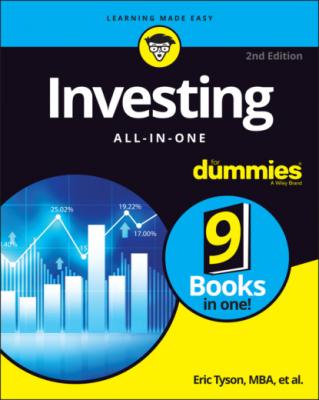Investing All-in-One For Dummies. Eric Tyson
Читать онлайн.| Название | Investing All-in-One For Dummies |
|---|---|
| Автор произведения | Eric Tyson |
| Жанр | Личные финансы |
| Серия | |
| Издательство | Личные финансы |
| Год выпуска | 0 |
| isbn | 9781119873051 |
| 52-Wk High | 52-Wk Low | Name (Symbol) | Div | Vol | Yld | P/E | Day Last | Net Chg |
|---|---|---|---|---|---|---|---|---|
| 21.50 | 8.00 | SkyHighCorp (SHC) | 3,143 | 76 | 21.25 | +.25 | ||
| 47.00 | 31.75 | LowDownInc (LDI) | 2.35 | 2,735 | 5.9 | 18 | 41.00 | –.50 |
| 25.00 | 21.00 | ValueNowInc (VNI) | 1.00 | 1,894 | 4.5 | 12 | 22.00 | +.10 |
| 83.00 | 33.00 | DoinBadlyCorp (DBC) | 7,601 | 33.50 | –.75 |
52-week high
The column in Table 1-1 labeled “52-Wk High” gives you the highest price that particular stock has reached in the most recent 52-week period. Knowing this price lets you gauge where the stock is now versus where it has been recently. SkyHighCorp’s (SHC) stock has been as high as $21.50, whereas its last (most recent) price is $21.25, the number listed in the “Day Last” column. (Flip to the later section “Day last” for more on understanding this information.) SkyHighCorp’s stock is trading very high right now because it’s hovering right near its overall 52-week high figure.
Now, take a look at DoinBadlyCorp’s (DBC) stock price. It seems to have tumbled big time. Its stock price has had a high in the past 52 weeks of $83, but it’s currently trading at $33.50. Something just doesn’t seem right here. During the past 52 weeks, DBC’s stock price has fallen dramatically. If you’re thinking about investing in DBC, find out why the stock price has fallen. If the company is strong, it may be a good opportunity to buy stock at a lower price. If the company is having tough times, avoid it. In any case, research the firm and find out why its stock has declined. (Chapter 4 in Book 3 provides the basics of researching companies.)
52-week low
The column labeled “52-Wk Low” gives you the lowest price that particular stock reached in the most recent 52-week period. Again, this information is crucial to your ability to analyze stock over a period of time. Look at DBC in Table 1-1, and you can see that its current trading price of $33.50 in the “Day Last” column is close to its 52-week low of $33.
Name and symbol
The “Name (Symbol)” column is the simplest in Table 1-1. It tells you the company name (usually abbreviated) and the stock symbol assigned to the company.
Dividend
Dividends (shown under the “Div” column in Table 1-1) are basically payments to owners (stockholders). If a company pays a dividend, it’s shown in the dividend column. The amount you see is the annual dividend quoted for one share of that stock. If you look at LowDownInc (LDI) in Table 1-1, you can see that you get $2.35 as an annual dividend for each share of stock that you own. Companies usually pay the dividend in quarterly amounts. If you own 100 shares of LDI, the company pays you a quarterly dividend of $58.75 ($235 total per year). A healthy company strives to maintain or upgrade the dividend for stockholders from year to year. (Additional dividend details are discussed later in this chapter.)
The dividend is very important to investors seeking income from their stock investments. For more about investing for income, see Chapter 3 in Book 3. Investors buy stocks in companies that don’t pay dividends primarily for growth. For more information on growth stocks, see Chapter 2 in Book 3.
Volume
Normally, when you hear the word “volume” on the news, it refers to how much stock is bought and sold for the entire market: “Well, stocks were very active today. Trading volume at the New York Stock Exchange hit 2 billion shares.” Volume is certainly important to watch because the stocks that you’re investing in are somewhere in that activity. For the “Vol” column in Table 1-1, though, the volume refers to the individual stock.
Volume tells you how many shares of that particular stock were traded that day. If only 100 shares are traded in a day, then the
